TAXANGLES A newsletter for proactive planning... In this edition... June 2021 Issue www.compassaccountants.co.uk No retained profits – Can you extract cash to cover your living expenses? Making a negligible value claim Amend your PSA for Covid-19 related benefits NIC and company directors Expenses and benefit returns for 2020/21 Tax Diary- June - July 2021
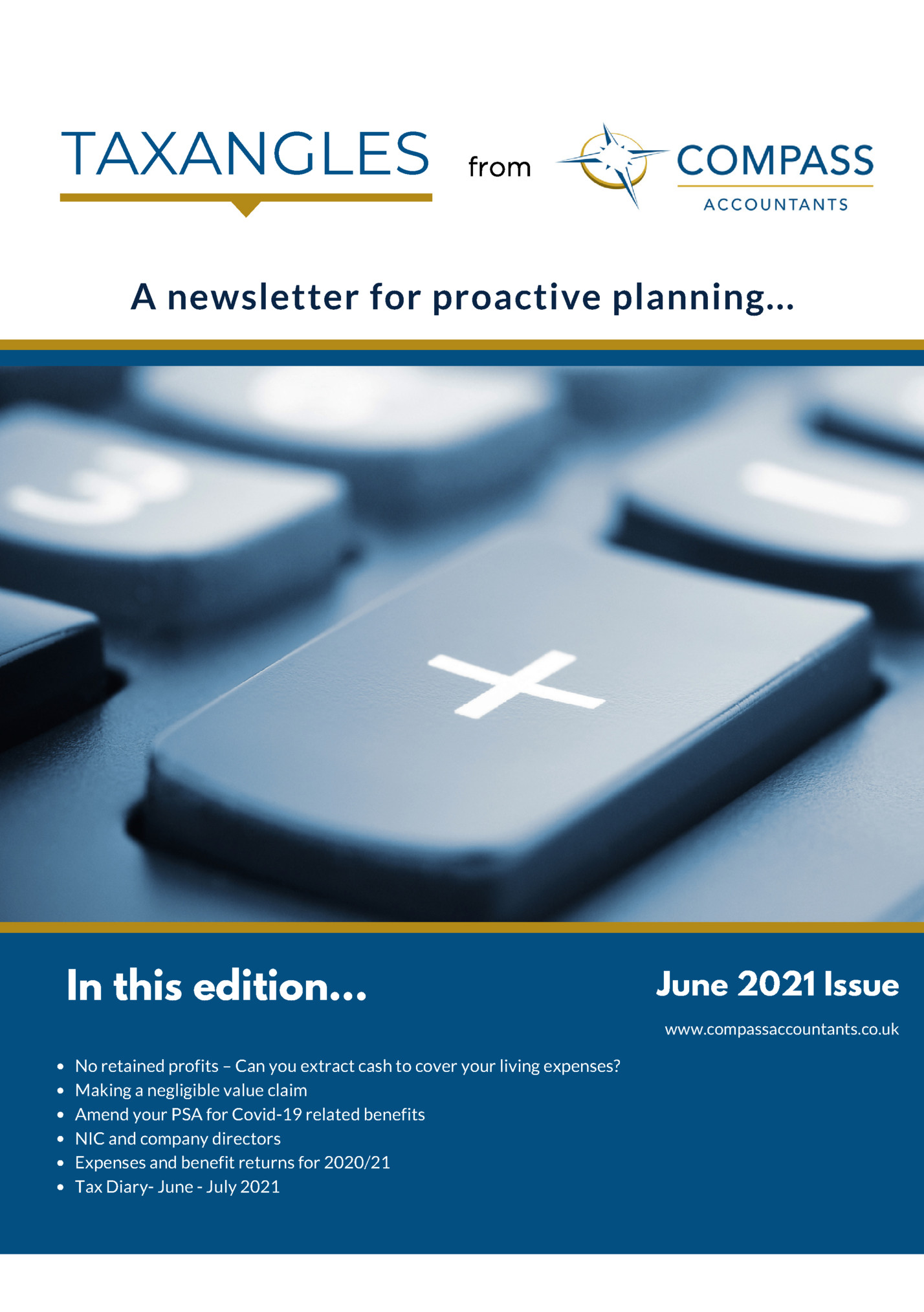
PAGE 2 If you operate through a limited company, for example as a personal or family company, you will need to extract funds from your company in order to use them to meet your personal bills. There are various ways of doing this. However, a popular and tax efficient strategy is to take a small salary which is at least equal to the lower earnings limit (set at £6,240 or 2021/22) to ensure that the year is a qualifying year for state pension and contributory benefits purposes, and to extract further profits as dividends. However, this strategy requires the company to have sufficient retained profits from which to pay a dividend. If the company has been adversely affected by the Covid-19 pandemic, it may have used up any reserves that it had. As dividends must be paid from retained profits, if there are none, it is not possible to pay a dividend. Are there other options for extracting funds to meet living expenses? 1.Pay additional salary or bonus Unlike a dividend, a salary or bonus can be paid even if doing so creates a loss – it does not have to be paid from profits. However, this will not be tax efficient once the salary exceeds the optimal level due to the National Insurance hit and the higher income tax rates applicable to salary payments. 2.Take a director’s loan If it is expected that the company will return to profitability, taking a director’s loan can be an attractive option. Depending when in the accounting period a loan is taken, a director can benefit from a loan of up to £10,000 for up to 21 months free of tax and National Insurance. If the company has returned to profitability within nine months of the year end, a dividend can be declared to clear the loan in time to prevent a section 455 tax charge from arising. If the account is overdrawn at the corporation tax due date nine months and one day after the year end, a section 455 tax charge of 32.5% of the outstanding amount must be paid by the company (although this will be repaid after the corporation tax due date for the accounting period in which the loan balance is cleared). 3.Put personal bills through the director’s loan account Another option is for the company to pay the bills on the director’s behalf and to charge them to the director’s loan account. Again, if the company has sufficient profits to clear the outstanding balance within nine months of the year end, a dividend can be declared to prevent a section 455 tax charge from arising. A benefit in kind tax charge (and a Class 1A National Insurance liability on the company) will also arise if the outstanding balance is more than £10,000 at any point in the tax year. 4.Provide benefits in kind Use can be made of various tax exemptions, such as those for trivial benefits and mobile phones, to provide certain benefits in kind in a tax-free fashion. Continued on page 3...
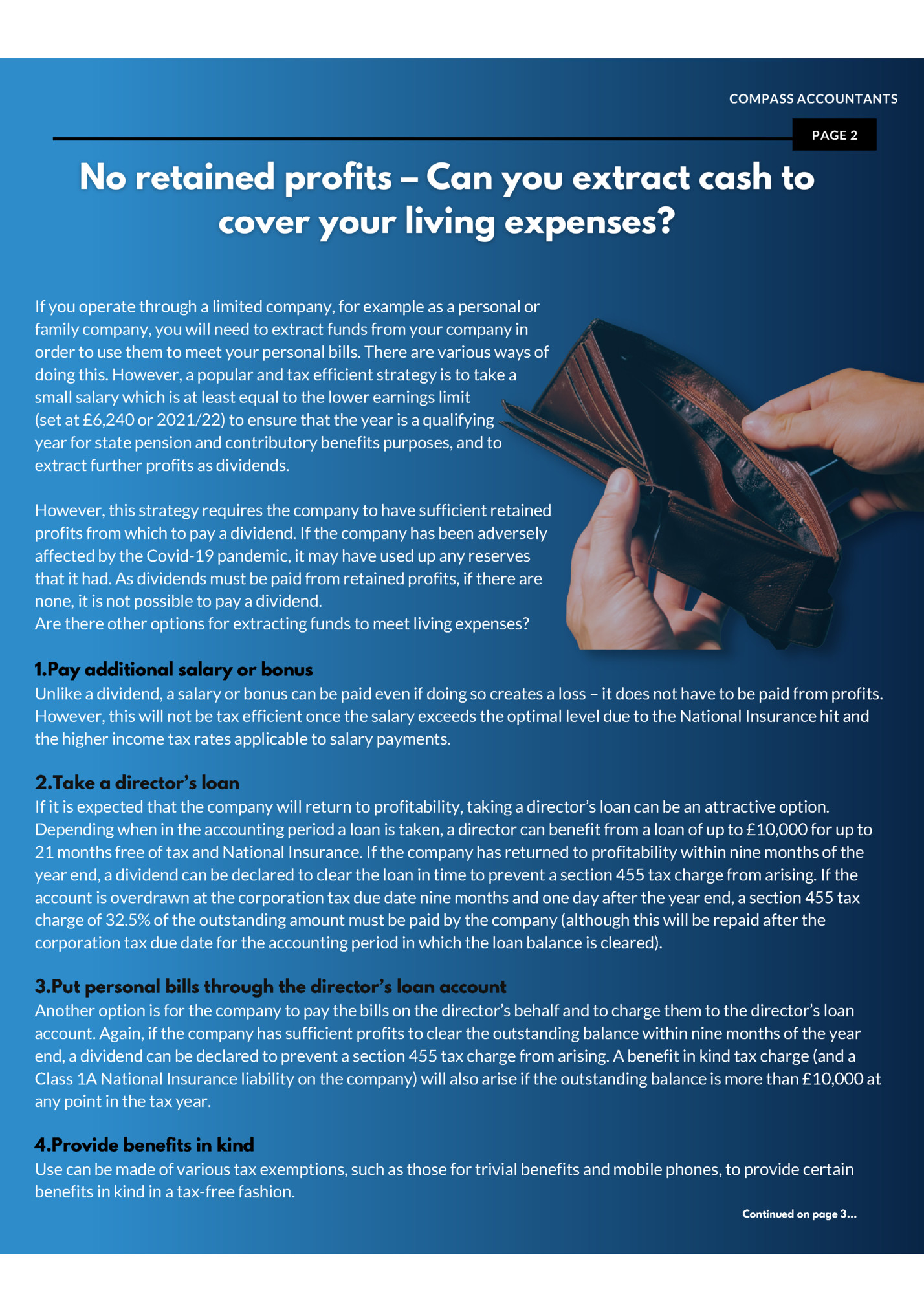
PAGE 4 PAGE 3 5. Pay rent If the company is run from the director’s home, the company can pay rent to the director for the office space. This should be at a commercial rate, and the director will pay tax on the rental income. However, there is no National Insurance to worry about and the rent can be deducted in computing the company’s profits, even if this creates a loss. As a bonus, if the extraction policy creates a loss, it may be possible to carry the loss back to generate a much-needed tax repayment. Making a negligable value claim Where assets that have become worthless, it may be possible to make a negligible value claim, allowing a loss to be realised which can be set against chargeable gains to reduce the capital gains tax liability. A negligible value claim can be made either on the self-assessment tax return or in writing to HMRC. Shares of negligible value Where the claim is for company shares and securities and the company is in liquidation, the following information must be given to HMRC: ·a statement of affairs for the company and any subsidiaries; ·a letter from the liquidator or receiver showing whether any return will be made to the shareholders; ·details of how this decision was reached (for example, a balance sheet where liabilities are significantly greater than assets); and: ·evidence that no recovery or rescue is likely (for example, a statement that the company has ceased trading). If a negligible value claim is being made for a company that is not in liquidation or receivership, comprehensive evidence to support the claim that the shares are of negligible value should be provided. Where the shares are unquoted, HMRC will generally accept that the shares are of negligible value where all the following conditions are met at the date of the claim: ·the company is registered in the UK; ·the company is not registered as a PLC; ·there is capital loss arising from the deemed disposal of shares following the negligible value claim; ·the company was in liquidation and insolvent or had ceased trading and had no assets. HMRC publish a list of quoted shares and securities that they accept as being of negligible value. Example Anna purchased 1,000 shares in an unquoted company for £10 each. On 1 May 2021 the company goes into liquidation. Anna successfully makes a negligible value claim, realising a loss of £10,000 which she can set against capital gains in the same or later tax years.
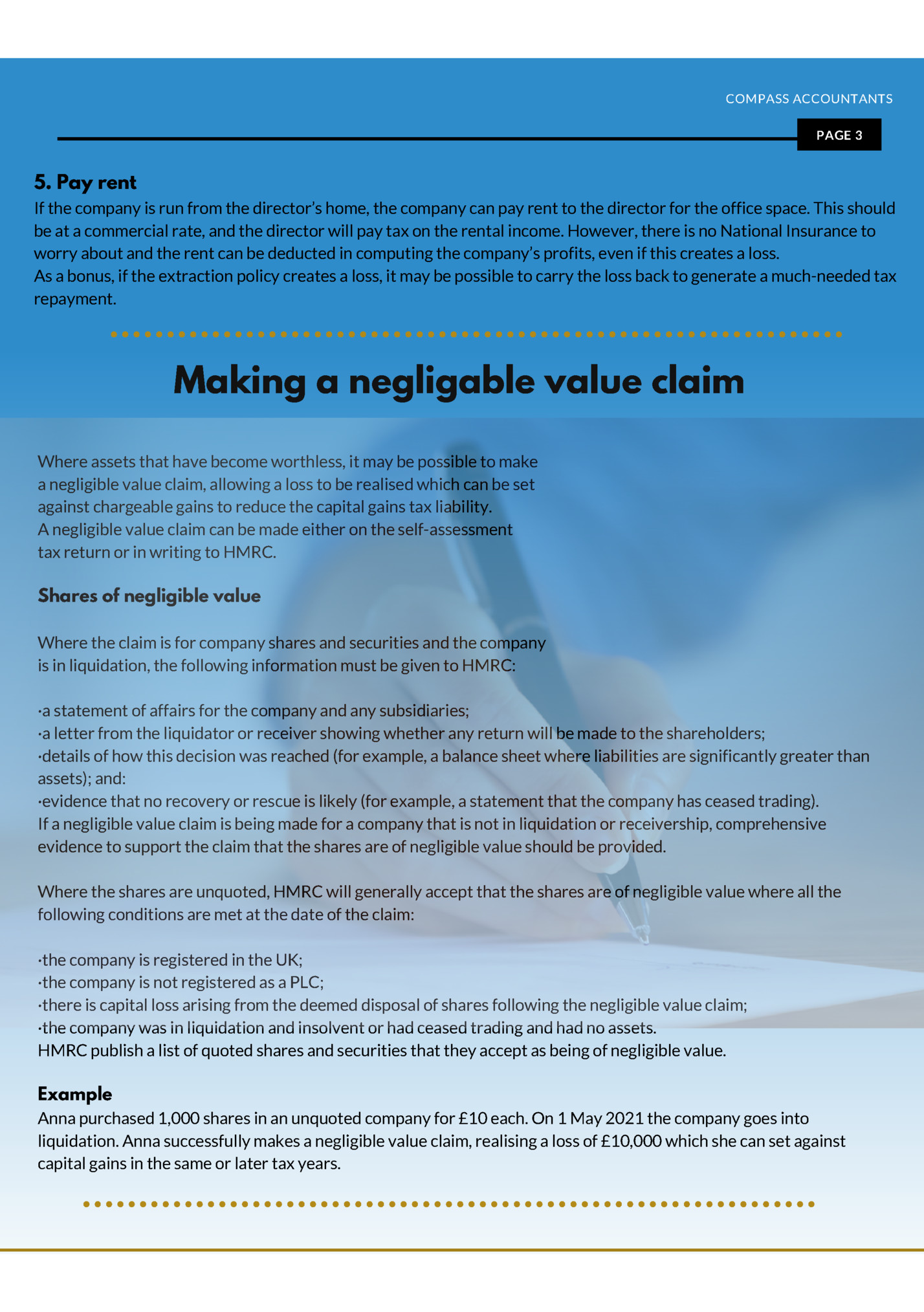
PAGE 4 A PAYE Settlement Agreement (PSA) enables an employer to meet the tax on certain benefits and expenses on the employee’s behalf. This can be useful to preserve the goodwill nature of a benefit. Not all benefits are suitable for inclusion within a PSA. To qualify a benefit must fall into one of the following categories: ·the benefit is minor; ·the benefit is provided irregularly; or ·the benefit is provided in circumstances where it is impractical to apply PAYE or to apportion the value of a shared benefit. A PSA can be used, for example, to meet the tax liability on the provision of an annual party that falls outside the associated tax exemption. Benefits that are exempt from tax do not need to be included. The tax and National Insurance payable on items included within a PSA for 2020/21 must be paid by 22 October 2021 where payment is made electronically, and by 19 October 2021 otherwise. An enduring agreement Once as PSA has been set up, it remains in place until cancelled or amended by the employer or by HMRC. Existing PSAs should be reviewed each year to ensure that they remain valid. Amending the PSA If a PSA needs to be altered, this must be done by 6 July following the end of the tax year to which it relates. The Covid-19 pandemic changed the way in which employees worked and may have changed the mix of benefits that were provided. Where a PSA needs to be amended in light to take account of Coronavirus-related benefits provided in the 2020/21 tax year, this must be done by 6 July 2021. Normally, HMRC would issue a new P626 (the PSA) when a PSA is amended. However, where amendments to the PSA relate solely to Covid-19 changes, rather than issuing a new P626, they will instead issue an appendix to the existing PSA. Covid-19 exemptions To remove the tax charge that would otherwise arise, a number of limited-time exemptions have been introduced in respect of Coronavirus-related benefits. These include an exemption for the provision of Coronavirus antigen tests, and also any reimbursement of the cost of the test where this is initially met by the employee. Where employees have worked at home during the Covid-19 pandemic and have bought equipment to enable them to do so, any reimbursement by the employer is also tax-free, as long as the provision would fall within the exemption for accommodation, services and supplies if provided directly by the employer. Coronavirus-related benefits that fall within the timelimited exemptions do not need to be included within a PSA. However, consideration may be given to adding any non-exempt benefits made available to employees during the pandemic to the PSA (for example, antibody tests), as long as they meet the qualifying conditions for inclusion. A new PSA If a PSA is not already in place, should an employer wish to set one up to deal with taxable benefits provided as a result of the Covid-19 pandemic, if the PSA is to have effect for 2020/21, it must be agreed with HMRC by 6 July 2021.
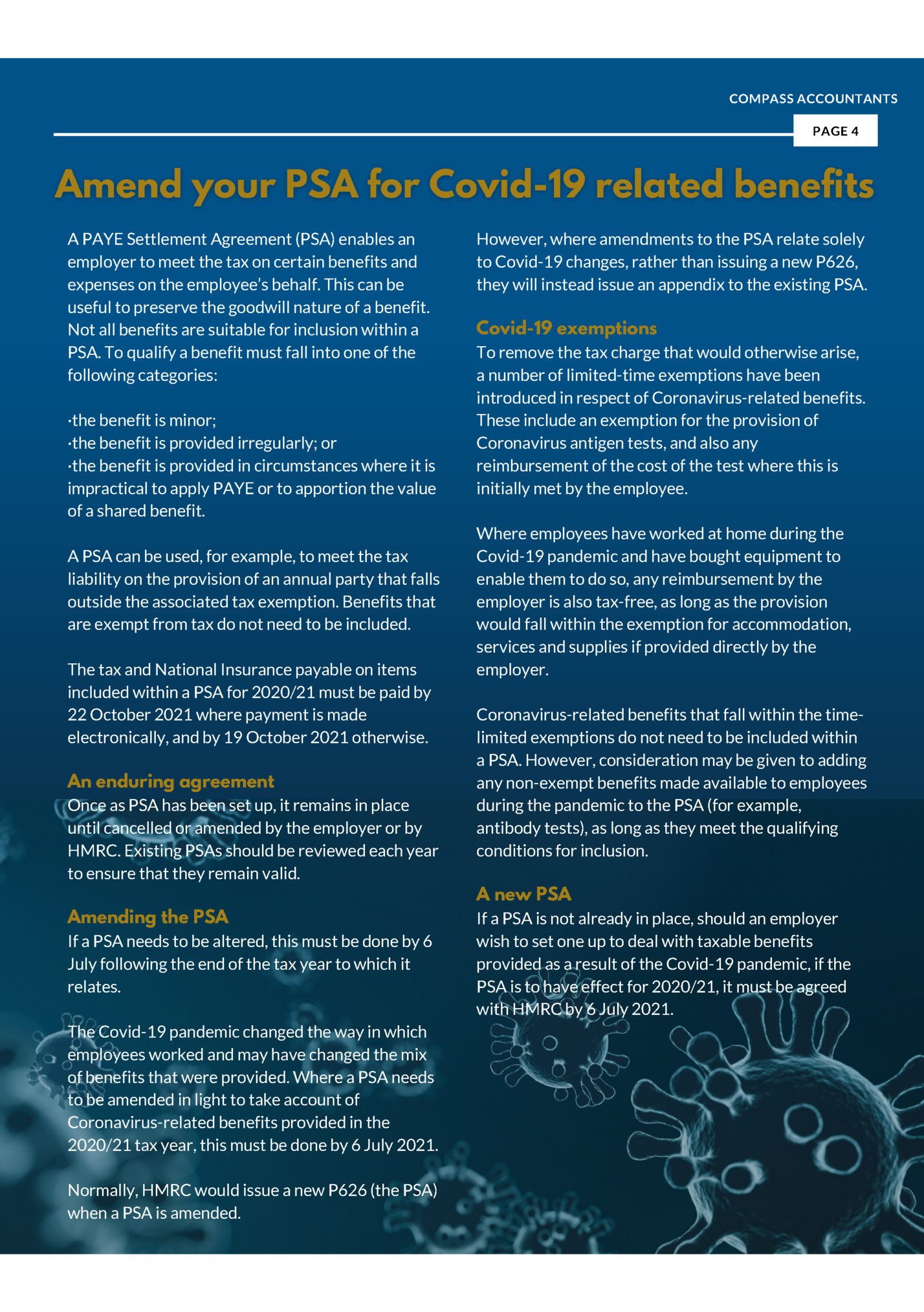
PAGE 5 NIC and Company Directors Special rules apply to company directors when it comes to calculating their Class 1 National Insurance liabilities. Why the rules Directors, particularly of personal and family companies, can control how and when they are paid and, in the absence of special rules, would be able to reduce their Class 1 National Insurance liability by manipulating the earnings period rules. The rules circumvent this. Annual earnings period Company directors have an annual earnings period for National Insurance regardless of their actual pay frequency. This means that if they do not opt to apply the alternative arrangements, their National Insurance liability is calculated cumulatively by reference to the annual thresholds. For 2021/22 these are as follows: Primary threshold Lower earnings limit Upper earnings limit Annual Threshold £9568 £6240 £50270 Example A director is paid £8,000 a month. In month 1, he pays no National Insurance as his earnings are below the annual primary threshold of £9,568. In month 2, his earnings for the year to date are £16,000. By applying the annual thresholds, his total liability on his earnings to date of £16,000 is £771.84 (12% (£16,000 £9,568)). As he paid no National Insurance in month, his liability for month 2 is £771.84. For months 3 to 6 inclusive, his earnings for the year to date fall between £9,568 and £50,270. Consequently, he pays employee’s National Insurance at 12% on his earnings for the month of £8,000, equal to £960 each month. In month 7, his earnings for the year to date are £56,000 (7 months @ £8,000 a month), on which total contribution of £4,998.84 (12% (£50,270- £9,568)) + 2% (£56,000 - £50,270)) are due. He has already paid £4,611.84 (£771.84 + (4 x £960)), leaving £387 due for the month. As his earnings for the year have now exceeded the upper earnings limit, he will pay National Insurance at the rate of 2% of all future payments – a liability of £160 per month. Applying the annual earnings period rules means that the contribution liability falls unevenly throughout the year. The liability for the year is £5,798.60 ((12% (£50,270 - £9,568) + ((2% (£96,000 - £50,270))). Alternative arrangements As seen in the example above, calculating the liability by reference to the annual thresholds on a cumulative basis each time the director is paid means that their pay is uneven throughout the year. To overcome this, the director can opt for their National Insurance to be calculated throughout the year on their earnings for each earnings period using the relevant thresholds for the earnings period, as for employees who are not directors, with an annual recalculation on an annual basis at the end of the year. If this basis is adopted, the director in the above example would pay National Insurance of £483.26 (12% (£4,189 - £797)) + (2% (£8,000 - £4,189))) each month for months 1 to 11, with a final payment of £482.74 in month 12. Over the course of the year, the annual liability (£5,798.60) is the same which-ever method is used, but collected differently. Directors can choose the method that suits them best.

PAGE 6 Expenses and benefits returns P11D and P11D(b) for 2020/21 need to be filed by 6 July 2021. Meeting this deadline is important as penalties may be charged for returns that are filed late. Form P11D A form P11D must be filed for every employee who has been provided with taxable benefits and/or expenses in the 2020/21 tax year which have not been payrolled or included in a PAYE settlement agreement. Benefits covered by an exemption can be ignored. The information that is needed in respect of each benefit depends on the nature of the benefit. In many cases, all that is needed is the cost to the employer of providing the benefit, any amount made good by the employee and the resulting taxable amount. However, for some benefits, such as company car and fuel and employment-related loans, more information is required. The taxable amount will normally be the cash equivalent value. However, where the benefit is made available under a salary sacrifice or other optional remuneration arrangement, the taxable amount should be worked out using the alternative valuation rules, unless the benefit is one of the few to which these rules do not apply. P11D(b) The P11D(b) is the employer’s declaration that all required P11Ds have been filed, and also the employer’s statutory Class 1A National Insurance return. When computing the Class 1A liability, it is necessary to take into account taxable benefits within the Class 1A charge returned on the P11D and also any payrolled benefits. If all taxable benefits provided in the 2020/21 tax year have been payrolled (or included in a PSA), there will not be any P11Ds to file; however, a P11D(b) is still required. Items included within a PSA are not included in the Class 1A National Insurance calculation on the P11D(b) – Class 1B National Insurance contributions are payable instead. If an employer has not provided any taxable benefits in 2020/21, but did in previous years, and receives either a paper P11D(b) or a P11D(b) reminder letter, they will need to complete a nil declaration online on the Gov.uk website to avoid being charged a penalty. Filing options There are various options for filing P11Ds and P11D(b)s: ·using a payroll software package; ·using HMRC’s Online End of Year Expenses and Benefits Service; ·using HMRC’s PAYE Online Service; or ·filing paper forms. Whichever method is used, the forms must be filed by 6 July 2021. Employees must be given a copy of their P11D or details of their taxable benefits by the same date. Any associated employer-only Class 1A National Insurance must be paid by 22 July 2021 if paid electronically, or by 19 July 2021 if paid by cheque.
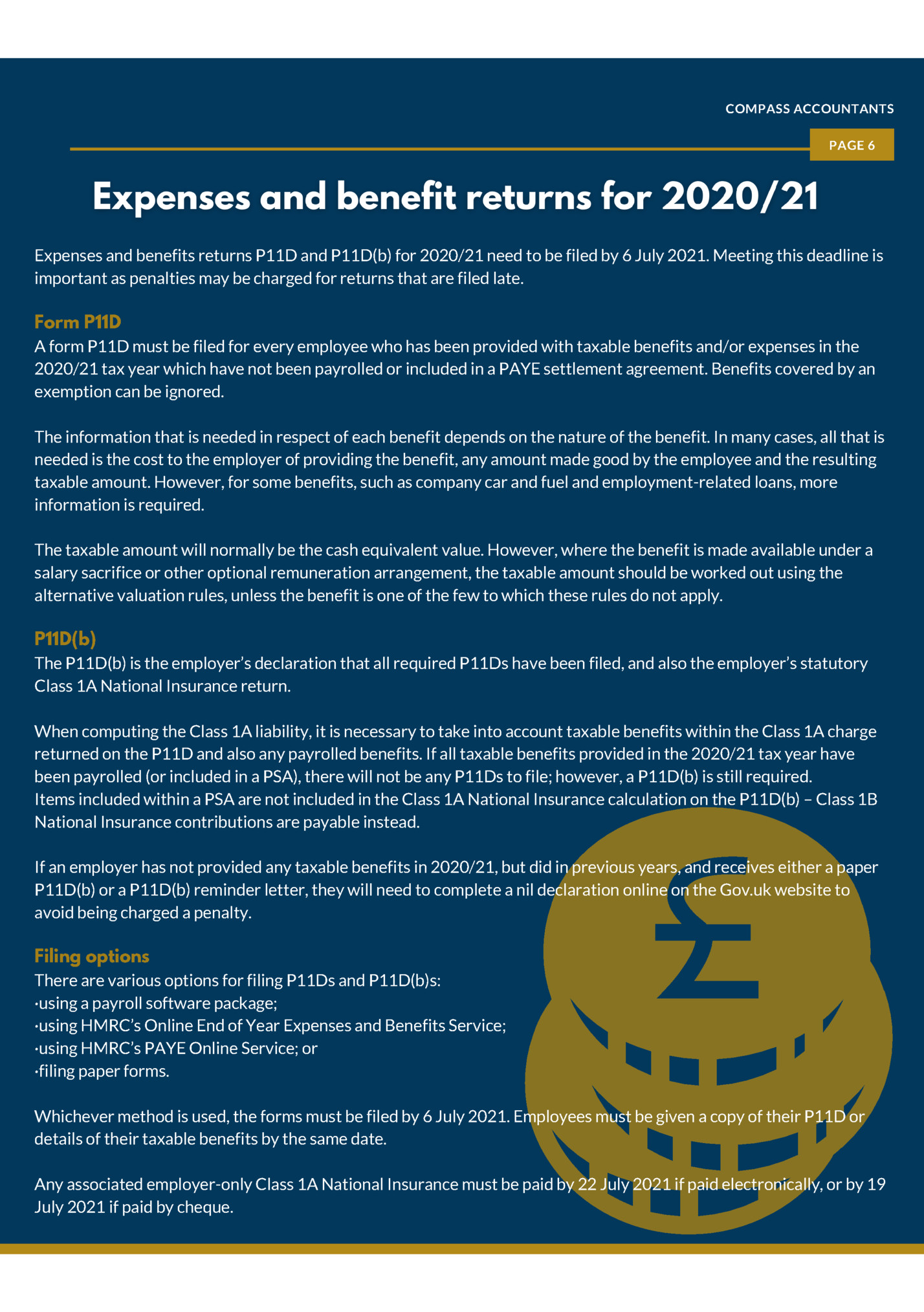
PAGE 7 TAX DIARY JUNE 2021 1 June 2021 – Due date for Corporation Tax due for the year ended 31 August 2020. 19 June 2021 – PAYE and NIC deductions due for month ended 5 June 2021. (If you pay your tax electronically the due date is 22 June 2021) 19 June 2021 – Filing deadline for the CIS300 monthly return for the month ended 5 June 2021. 19 June 2021 – CIS tax deducted for the month ended 5 June 2021 is payable by today. 1 July 2021 – Due date for Corporation Tax due for the year ended 30 September 2020. 6 July 2021 – Complete and submit forms P11D return of benefits and expenses and P11D(b) return of Class 1A NICs. 19 July 2021 – Pay Class 1A NICs (by the 22 July 2021 if paid electronically). 19 July 2021 – PAYE and NIC deductions due for month ended 5 July 2021. (If you pay your tax electronically the due date is 22 July 2021) 19 July 2021 – Filing deadline for the CIS300 monthly return for the month ended 5 July 2021. 19 July 2021 – CIS tax deducted for the month ended 5 July 2021 is payable by today. For further information on any of the stories in this month’s newsletter, or for any other matter that Compass Accountants can assist you with, please contact us on 01329 844145 or contact@compassaccountants.co.uk To subscribe to the newsletter, so that each edition is delivered to your inbox, go to www.compassaccountants.co.uk and add your contact details. Compass Accountants, Venture House, The Tanneries, East Street, Titchfield Hampshire. PO14 4AR
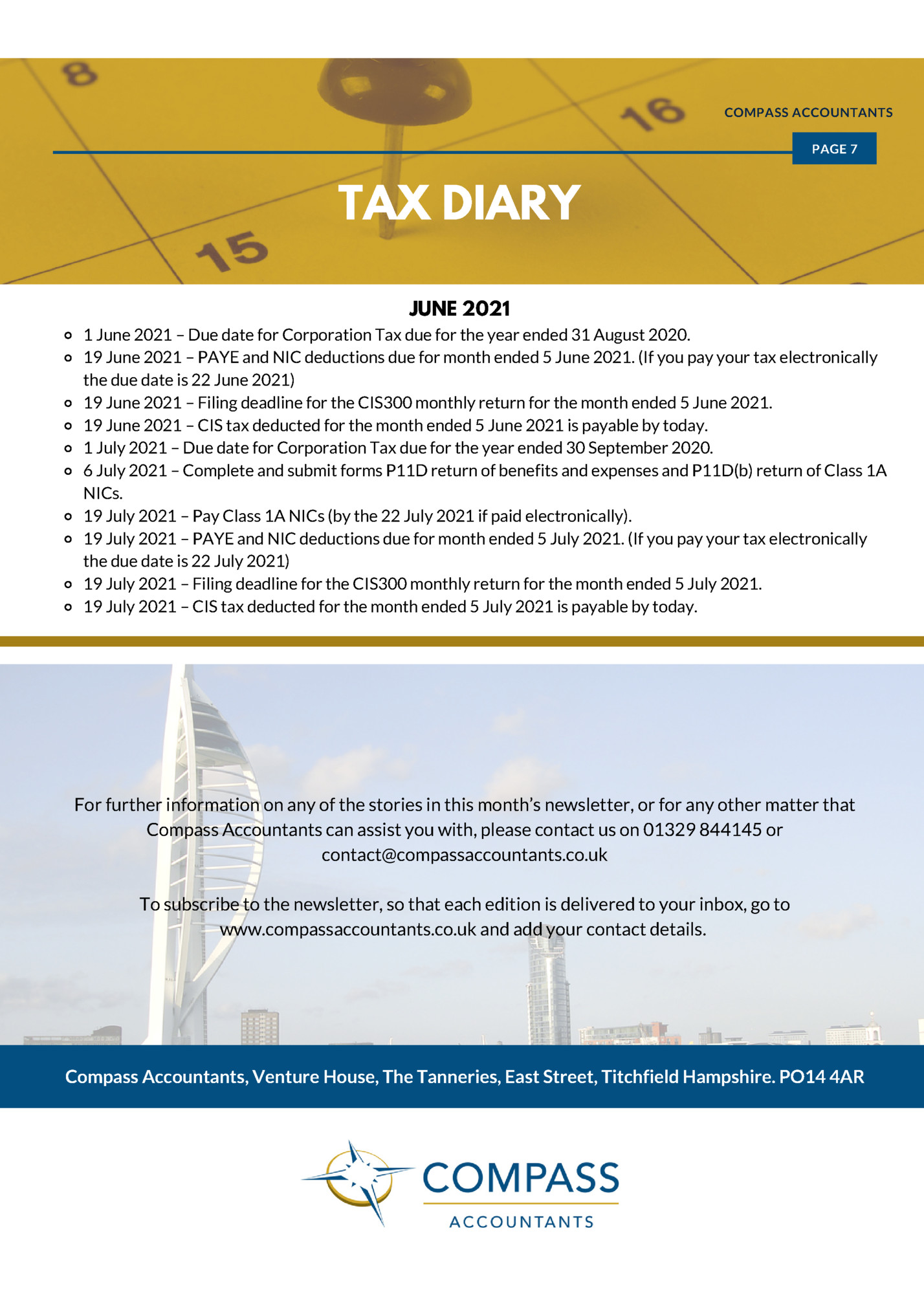
Fleepit Digital © 2021